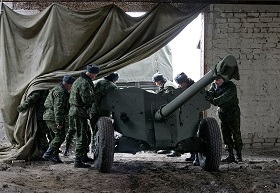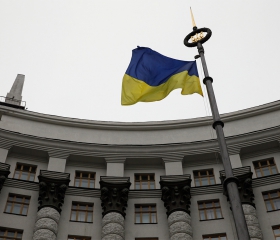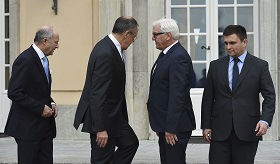Are the Minsk Agreements Doomed?
Presidential Press Service
In
Login if you are already registered
(no votes) |
(0 votes) |
Ph.D. in Political Science, Research Fellow at the Faculty of Political Science, Lomonosov Moscow State University
Behind NATO’s aggressive rhetoric and John Kerry’s assurances given to Kiev there is no glimpse of any decisions concerning the future of Ukraine. While at the initial stage of the Ukrainian crisis there were callsfor “a new Marshall Plan,” it has now become clear that the USA is keeping its support to a minimum and does not intend to switch its attention to that state. Today the implementation of the Minsk agreements is more an internal than an external problem for Ukraine.
Against the background of the NATO Warsaw summit on 8–9 July 2016 Washington tried to reassure its partners in the post-Soviet space – Georgia and Ukraine –to whom it promised NATO membership 8 years earlier. The NATO summit de facto confirmed that in the medium term the accession of Kiev and Tbilisi to NATO has been taken off the NATO agenda. However, Washington has indicated that it is still seeking to strengthen its influence in these two countries in spite of the lukewarm attitude to the idea on the part of Paris and Berlin and the signs of Britain drifting away from the European Union.
A tour with guarantees
On the eve of the Warsaw summit US Secretary of State John Kerry travelled to Georgia and Ukraine to reassure the governments there of continued Washington’s support. The reason is that the “aggressive” wing of NATO (above all Poland and the Baltic countries which are demanding the deployment of permanent NATO bases on their territories) is grappling with the tactical task of “reviving NATO’s mission” by “containing” Russia.
At the same time some influential NATO members are committed, if not to a dramatic de-escalation of the situation in the East, at least to preventing any worsening of the confrontation with Russia. Contrary to the aggressive rhetoric, the Obama Administration has decided to limit escalation in Eastern Europe; refusing, for now, to set up permanent NATO war bases on the eastern borders and to supply arms to the Ukrainian government. It is no wonder, therefore, that Kiev and Tbilisi need to be reassured of Washington’s continued support.
Some influential NATO members are committed, if not to a dramatic de-escalation of the situation in the East, at least to preventing any worsening of the confrontation with Russia.
A special programme had been prepared for the Ukrainian President. After receiving the US Secretary of State in Kiev, Petro Poroshenko flew to Warsaw where he had several top-level meetings including a conversation with Barack Obama, in which Poroshenko received moral and political support. In exchange, Kiev’s demand for supply of lethal weapons was shoved under the rug. The declaration issued after the meeting of the Ukraine-NATO Commission stresses commitment to promoting cooperation, but does not mention the subject of future Ukrainian membership.
It should be noted that earlier in the official announcement the US State Department expressly said that the aim of Kerry’s visit to Georgia was to support Tbilisi’s “Euro-Atlantic aspirations” while the aim of his visit to Ukraine was to “discuss the programme of reforms” and “implementation of the Minsk agreements.”
Slowing down escalation
However, the Obama Administration refrains from bringing public pressure on Poroshenko regarding the implementation of the Minsk agreements. All one can glean from American statements is a growing concern over the increased frequency of ceasefire violations in the conflict zone in Eastern Ukraine. While in Kiev, John Kerry declared that the Minsk agreements “were doomed to failure” without ensuring “real security” in Donbass, and earlier, in late June 2016, Victoria Nuland visited Minsk with the declared aim of discussing “reform priorities” in Ukraine. Then, in what has become a tradition, the Assistant Secretary of State headed for Moscow.
Obviously, the Obama Administration tries to be updated on the Ukrainian events and engage with Moscow. First, a sharp escalation in Ukraine could trigger a full-scale conflict with both Russia and the USA involved. Such developments could lead to unpredictable consequences, for example, a split within the North Atlantic Alliance over possible interference in the Ukrainian crisis.
Back in 2015, the Obama Administration preferred to impose sanctions and use possible supplies of lethal weapons to Kiev as the next potential step in the event of escalation. At the same Victoria Nuland and the Russian Deputy Foreign Minister Grigoriy Karasin started active communication, while John Kerry resumed visiting Russia after having stated earlier his intention to isolate Moscow.
Besides, in January 2017 Obama will leave the White House and, like any outgoing president, he is concerned about his foreign policy legacy. It is worth noting that The Washington Post reported that the Obama Administration was thinking of extending START III treaty with Russia by five years in order to consolidate Obama’s achievements in foreign policy. Escalation in Ukraine may of course have repercussions in Syria where some coordination between Moscow and Washington has been achieved through strenuous diplomatic efforts.
While in Kiev, John Kerry declared that the Minsk agreements “were doomed to failure” without ensuring “real security” in Donbass.
That is why the Obama Administration today is not interested in re-initiating the conflict, although it is not publicly expressing any readiness to take new steps or make serious compromises to settle the crisis either.
Will NATO help?
Clearly, the fact that Moscow, Washington and the Western European governments are seeking to limit any escalation of the Ukrainian crisis does not mean that Washington would be ready to use all levers to pressure Kiev to abide by the Minsk agreements. It is hard to imagine Washington starting to talk to the Ukrainian authorities in the language of ultimatums considering that, in the past 25 years, seeking to gain more influence on Ukraine, the USA poured in billions of dollars in various aid and civil society support programmes, not mention political capital. This strategic line is prompted by geopolitical imperatives. As things stand, Kiev gains room for manoeuvre and is taking a tough stand in trying to “roll back” the undesirable Minsk-2 which had been signed against the background of the military setbacks of the government forces and under pressure from their Western colleagues.
Increasingly, the conventional wisdom is that the Minsk agreement is the ‘best of a bad job.’ Today these documents ensure an uneasy truce, while on the diplomatic side the struggle for concessions among the parties of the agreement continues.

Vostock Photo
Anton Naychuk:
Development Scenarios for the Conflict in
Eastern Ukraine: A View from Kiev
Although from the political point of view NATO-Ukraine relations have a logical justification, in practice they do not automatically increase military safeguards for Kiev. The situation in Ukraine provokes a split within NATO. Today, the alignments within NATO over the Ukrainian issue are predictable and manageable. However, if the camp that seeks confrontation ratchets up the tensions, the split within the bloc may deepen.
Berlin, Paris and Rome are taking small steps to defuse tensions in Eastern Europe. Thus, on 8th July, 2016 the French President made a statement that ran counter to NATO rhetoric when he said that Russia, for France and Europe, is “not an adversary and not a threat,” but “a partner which sometimes may use force.” Earlier, the Italian Prime Minister Matteo Renzi attended the St. Petersburg International Economic Forum and the German Foreign Minister Frank-Walter Steinmeier described NATO exercises in Poland in June 2016 as “sabre rattling”.
Under these conditions, Kiev can enlist more support by looking to Washington than to Brussels. At the same time, the Ukrainian government is still committed to switching to NATO standards over the next few years. It is too early to assess the chances of success considering the many unknown variables. These include the economic woes, dependence on foreign financing, the simmering civil conflict which is not confined to Donbass, and finally, the overall political instability.
Kiev can enlist more support by looking to Washington than to Brussels.
Besides, while the eastern members of the Euro-Atlantic community, such as Poland and the Baltic countries, see NATO enlargement and increased military presence on the eastern borders as possible advantages, “old Europe” sees this as an additional risk for the European Union which already has its hands full of problems. As long as countering the “threat from the East” remains on the level of an artificially dramatized phantom challenge, it may prove to be a unifying factor in the EU. However, it is hard to predict the reaction of the public opinion in various political circles in Europe if this threat becomes real.
How to make the Minsk agreements work?
The Obama Administration today is not interested in re-initiating the conflict, although it is not publicly expressing any readiness to take new steps or make serious compromises to settle the crisis either.
Behind NATO’s aggressive rhetoric and John Kerry’s assurances given to Kiev there is no glimpse of any decisions concerning the future of Ukraine. While at the initial stage of the Ukrainian crisis there were calls for “a new Marshall Plan,” it has now become clear that the USA is keeping its support to a minimum and does not intend to switch its attention to that state.
Plans for a “Ukrainian Taiwan” or, as some of the more odious figures in the US establishment called for, “a Russian Vietnam” have failed. The reason is not only the reaction of “old Europe” and the real chance of slipping into a military conflict with Russia, but also it has something to do with what a leading Western expert on the region called privately “the Byzantine labyrinths of Ukrainian politics” where the USA may pour resources without being able to control their use. Meanwhile, the risk of being drawn into intrigues between elites is fairly high. Should the US involvement in the situation in Ukraine increase, the crisis in relations between Washington and Moscow would deepen.
As a result, Ukraine finds itself in a crisis of “borderland” or “double periphery” when each potential external donor is capable of half-hearted measures not willing and not being able to lend full-scale support. This increases the risks of further deterioration of the economic and socio-political situation inside Ukraine.

Anton Naychuk:
Domestic Policy-specific Characteristics of
Constitutional Process Implementation in
Ukraine
The way out is tedious work to look for a new balance of interests inside Ukraine. Today the implementation of the Minsk agreements is more an internal than an external problem for Ukraine. The delay in compliance with the Minsk agreements is undoubtedly prompted by expectations of US Administration change. If substantial progress in the implementation of the Minsk agreements is achieved under Obama, the next US President could launch the process of normalising relations with Moscow, aware of an ascendant China. At the same time the Ukrainian government is afraid to provoke an internal political crisis or set a precedent for other regions in the country not all of which are under full control of the central authorities. Suffice it to mention the clashes in Мukachevo in the west or the “Amber People’s Republic” in the north-west of the country. Apparently the European Union is aware that the Kiev authorities have little wiggle room and that is why criticism of Russia over the implementation of the Minsk agreements is muted. Bringing pressure on Moscow is futile and even dangerous considering that the ball is in the court of the Kiev authorities.
Today it is important to determine how the EU (or at least its Franco-German nucleus), Russia and the USA see the solution of the Ukrainian crisis and to try to find common ground between these various visions through mutual concessions. Without bridging the gaps between visions of the region’s future it is impossible to create effective incentives for internal Ukrainian politics. The West should cancel its plans to draw Ukraine into NATO. Despite the government’s declaredwish to join the Alliance, there is no consensuson this issue inside the country.
The above scenario of external coordination and internal balance of interests may seem a fantasy today. The time to implement it has not yet come because the situation in Ukraine is too uncertain, not to speak of the active propaganda.
Today the implementation of the Minsk agreements is more an internal than an external problem for Ukraine.
The external parties to the crisis around Ukraine have so far decided to confine themselves to the “zero option” of holding back the escalation. Therefore the stationing of several thousand NATO troops on the Alliance’s eastern borders while Warsaw and Vilnius demanded permanent bases is largely a symbolic act which, however, provides grounds for a Russian response which need not be symmetric. Anyway, moving battalions of several NATO countries to the Baltic countries and Poland, however few they may be, deepens dividing lines. More fundamental problems, for example, EuroBMD, are not being addressed either, which makes the scenario of international coordination over the Ukraine issue still less likely.
Towards a new balance of interests
The above scenario of coordination being unlikely does not mean that the leading players should turn a blind eye to the situation in Ukraine. In fact, the country, in spite of tough rhetoric from Kiev and a crack-down on dissent, is witnessing a struggle between different interests and constant balancing between different decision-making centres.
Oligarchic groups, as they are called, are trying to conduct dialogue with Moscow, Brussels and Washington. In addition, Ukraine has some influential politicians who were forced to leave for Russia, but who have preserved their resources and want to return to Ukraine and are still actively involved in its internal politics. If the authorities in Kiev and Western governments continue to ignore the civil split and imbalance of interests of different political actors in Ukraine, the country may follow the “Baltic scenario” of excluding minorities from political life. However, considering the size of Ukraine, and its cultural and political diversity that would sooner or later cause a power paralysis and deepen the internal crisis. Kiev, of course, brushes aside this argument. However, the huge numbers who took part in the recent cross-bearing processionof the Ukrainian Orthodox Church of the Moscow Patriarchate in Ukraine, and attempts by radical forces to disrupt the event, indicate major cultural rifts within Ukraine.
It is important to determine how the EU Russia and the USA see the solution of the Ukrainian crisis and to try to find common ground between these various visions through mutual concessions.
The first step in search of a new balance of interests may be a multilateral discussion of the economic future of Ukraine’s western and eastern regions. Much of Ukraine’s heavy industry, concentrated in the East, has neither big enough markets, nor the EU technical standards. Meanwhile Russian markets and capitals could be used to preserve and modernise the industrial potential of South-East Ukraine. We are talking about tens and hundreds of thousands of jobs which support urban culture. Further de-industrialisation is likely to radicalise major social groups in Ukraine and make the situation less predictable. This is hardly in the interests of any serious international players, if one bears in mind the challenges that have overwhelmed Europe.
The European Union, for its part, may be more interested in the development of agriculture in Western Ukraine, in its light industry, in building assembly plants and in managing labour migration.
If the conflict remains stable and deescalated there will be more opportunities for diplomacy at various levels, which would permit a resumption of dialogue. De facto dialogue has had to be resumed, notwithstanding the initial refusal of the European Union to have any consultations with Russia on a free trade zone with Ukraine. These include three-way consultations on free trade zone issues and the Minsk agreements. Dialogue also continues at the non-public and unofficial levels.
It may take years to fully implement the scenario of a new balance of interests in Ukraine. The situation would greatly depend on public sentiment and the political situation, including a change of generations amongst the Ukrainian leaders. However, seeking a new balance of affairs puts the credibility of Ukraine as a state is at stake. The experiment of forcible nation-building according to the Baltic scenario has no chance in Ukraine, would serve as a mere waste of time and may even lead to a new spiral in internal destabilisation.
As regards the overall situation in Europe the Ukrainian crisis needs to be further localised. By going along with the policies of some Eastern European governments aimed at spreading the impact of the Ukrainian crisis on the whole range of the relations between the West and East of Europe it is all too easy to become a hostage to the spiral of confrontation and provoke a deepening of dividing lines for decades ahead. The current spiral of confrontation is enough to take off the agenda the issue of a common security system and “integration of integrations” in Europe for the foreseeable future.
(no votes) |
(0 votes) |





